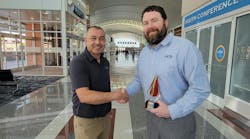We live in an exciting time — and technology can take a lot of the credit. But when advances come as quickly as they do, it’s easy to start taking them for granted. So on a recent tour of the in-line baggage handling system at Dallas/Fort Worth International Airport recently, my immediate reaction was, “Wait, you mean most airports don’t have this?” My editor assures me that this is not an uncommon first reaction.
It was a thorough tour, going through all the passive and active screening rooms in the newly-built terminal D, as well as out onto the airfield. (My first time walking around an airfield — definitely a highlight.) The system is a maze of conveyor belts, bar code scanners, (RFID is planned for DFW), and automatic baggage sorters — not an easy thing to integrate into a pre-existing facility.
By contrast, the screening rooms are oases scattered throughout. Inside, brightly-lit, air conditioned rooms seem a pleasant place to work. Computer monitors let screeners know which bags are flagged for further screening, and which have been cleared.
Most impressive were the TSA employees themselves. I visited during a slow part of a weekday afternoon, so the screeners had time to enthusiastically go through the finer points of the system. Perhaps having the appropriate technology and space in which to do their work helps. Regardless, if technology is only as good as the people who are trained to operate it, then DFW has a great system.
For all the complaints about air travel one hears from the mainstream media and general public, (Passenger’s Bill of Rights, anyone?) it’s quickly forgotten what a luxury it is to travel halfway around the world in a mere 15 or 20 hours. Most people would probably agree that dealing with delays and layovers are a lot better than, say, spending weeks on a ship to get from A to B.
It’s also easy to take for granted the giant X-ray machines eating up most of the room in airport lobbies around the country. They really don’t belong there. And the amount of baggage left unattended once it’s crossed that magical yellow line taped on the floor — with warnings about unattended bags echoing through the airport — always leaves me paranoid and hovering over my bag until an actual, live TSA screener has it.
Finding the money
As always, implementing the newest technology requires a fair amount of cash from someone with deep pockets — in this case, the government. In the President’s FY2009 budget, TSA requested a 50-cent temporary surcharge to the current $2.50 passenger fee — 50 cents added to each leg of a one-way trip, capped at a dollar. The four-year surcharge would begin in FY09 and sunset in FY12, according to a TSA spokesperson. The revenue would combine with the existing $250 million Aviation Security Capital Fund source, raising the amount allotted for checked baggage systems to about $670 million.
But word on the street, according to ACI-NA senior vice president of security and facilitation Charles Chambers, is that the temporary surcharge proposal is basically dead on arrival.
“We’re not really expecting to see the fee increase to actually occur,” Chambers comments.
Instead, he says, keep an eye on the Homeland Security Advisory Council’s Essential Technologies Task Force (ETTF). Chartered by the Department of Homeland Security, the task force is charged with looking into innovative funding for a broad range of technologies, including for airports in-line baggage handling, among others.
“You understand, what’s innovative for the federal government is probably normal elsewhere,” notes Charles Adams, ETTF director. He says in this case, the funding would include any other paid-up-front procurements.
Adams says the task force’s report is due to the Homeland Security Advisory Council sometime in April. Depending on the council’s approval, he estimates that the report will be posted online and available to the public in July. From there, says Chambers at ACI-NA, some of the recommendations may end up in legislation.
“Congress has been very sympathetic to doing innovative funding,” Chambers notes.
In the meantime, reimbursement remains a viable option, though it is not a part of the task force’s innovative funding plans.
Chambers says the systems are a definite priority, especially with the increasing ridership expected in the near future — like an extra 250 million passengers by 2012. “That’s not really a long way off,” he says.
As someone recently reminded me, TSA is still a young agency. It wasn’t that long ago that there weren’t any baggage X-rays, either in-line or as lobby eyesores. Technology is advancing rapidly, and it can be tough — and costly — to keep up with it. But as DFW exemplifies, it can be well worth it.




